Site Menu:
| This is an archived Horseadvice.com Discussion. The parent article and menus are available on the navigation menu below: |
| HorseAdvice.com » Diseases of Horses » Lameness » Muscle & Tendon Diseases » Tendon Laxity and Contracture » |
| Discussion on Contracted Tendon and Abnormal Hoof Growth in 7 week Foal | |
| Author | Message |
| Member: cathy33 |
Posted on Tuesday, Aug 11, 2009 - 12:16 pm: Over the past 2-3 weeks my colt has developed very upright pasterns in both front feet and I have now noticed that the new hoof growth is very upright with wider growth rings at the heelscompared to the toe. The original foal foot is at the correct angle and the heels touch the ground.Initially my vet suggested turning the mare and foal out in a smaller paddock to prevent over-exercising. With no signs of improvement, he has now instructed that I reduce the nutrition to mare as it would seem that my foal is just growing too fast. I have read your article on tendon contracture and it seems that reducing the quality of the mares milk should help. My vet proposed reducing the mare's current diet by about 25% and also reducing turnout to 4 hours a day on restricted pasture. He has said that I should soak the hay I feed for 12 hours to reduce the calorie content. My concern is that he said, contrary to what your article advises Dr O, that I should not feed a vitamin and mineral supplement. I am really concerned that the mare will diet will be detrimentally deficient in vits/mins and probably protein. I would really appreciate anyones views on this. This foal of mine keeps giving me worries and I so want to do the right thing by him! |
| Member: dres |
Posted on Tuesday, Aug 11, 2009 - 1:12 pm: Cathy can you post some pictures of his legs and hoofs..?On the first day God created horses, on the second day he painted them with spots.. |
| Member: juliem |
Posted on Tuesday, Aug 11, 2009 - 3:02 pm: Cathy, it'll be hard to help or make suggestions without pictures of the foals legs and feet. They should be taken from the side, with the camera at the same level as the hoof pastern area. Also a full side view of the foal--a conformation shot. Be sure the light is behind you and good luck with posting them. It's really not that difficult once you get the hang of it and if you can't there are members who will do it for you after you email them the pics. |
| Member: vickiann |
Posted on Tuesday, Aug 11, 2009 - 3:55 pm: Cathy,I am not an expert by any means but will tell you what I believe that my very talented farrier would have to say about this situation. He would read that extra growth and determine that the horse is trying to heal something on his own by trying to put down extra foot where it is presently needed. He would not try to change angles or do anything corrective but would simply balance the feet laterally and medially. He would recommend good nutrition but nothing overboard. Given good balance and exercise he would expect the youngster's feet to go through an amazing process resulting in a good end result. |
| Moderator: DrO |
Posted on Wednesday, Aug 12, 2009 - 5:44 am: Hello Cathy,If the problem is excess energy in the sucklings diet resulting in too rapid growth, maintaining a normal mineral and vitamin intake to the mare will not effect the amount and quality of the milk. It just helps keep the mare healthy during a time of restricted energy intake. I am uncertain what your veterinarians position is. Has he looked at the reduced diet and decided it is OK with respect to these ancillary nutrients? How old is this foal? If the mare is in a fleshy condition reducing feed intake may not have much effect as she has reserves. Sometimes in these cases some have configured mammary covers, foal masks, or early weaning so you can control intake is most helpful, for more on this see Horse Care » Equine Nutrition, Horse Feeds, Feeding » Feeding and Caring for the Orphan Foal. DrO |
| Member: cathy33 |
Posted on Wednesday, Aug 12, 2009 - 12:18 pm: Thank you everyone for your messages and advice. I have attached some photos of his feet but forgot to take the full body and leg shots so will post those tomorrow (above the fetlock joint I think his conformation is pretty good however).The first photo is of his left fore which is the better of the two. The other 3 photos are of his right fore (apologies that one is sideways on). I think you will clearly be able to see the problem. Dr O, my mare is in quite fleshy condition although you can just see the outline of her ribs. Her weight is around 1050 pounds (16 hands) and her current diet consists of: 18 pounds soaked grass hay (protein 6-7% from analysis) 2 1/2 pounds of stud balancer (protein 32% with balanced supply of vits and mins but low in calories) 2-4 hours of turnout on grass (14-16% protein) Before here nutrition was reduced, she was on 3 1/2 pounds stud balancer, 8 hours turnout on grass and 8 pounds of unsoaked hay. I could try a muzzle ( I have one for my miniature shetland pony that he could use) How long should I put it on for do you think?. Harley is only 7 weeks old so I think it would be too early to wean. In addition to the reduction in diet, my vet has agreed with my farrier that he should keep a regular check on the colt's feet (every 2-3 weeks) and trim the heels when required. From the photos, how severe do you think the problem is and do you think the current diet and approach to farriery appropriate at this stage? Many thanks, Cathy PS Perhaps I should add that Harley has has no swelling in the joints and has not shown any lameness. 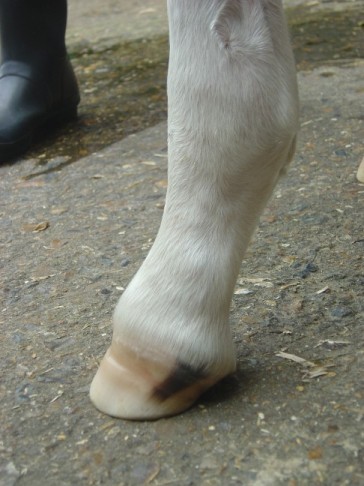 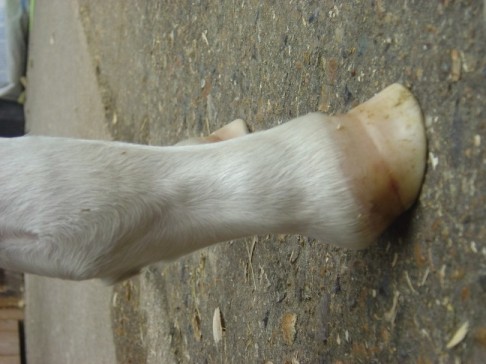 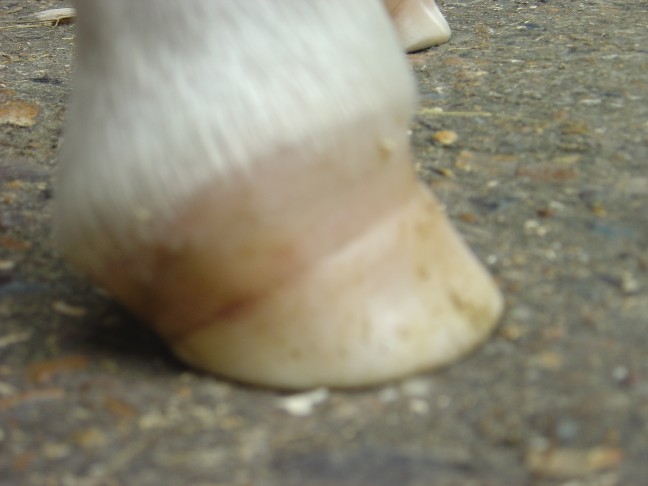 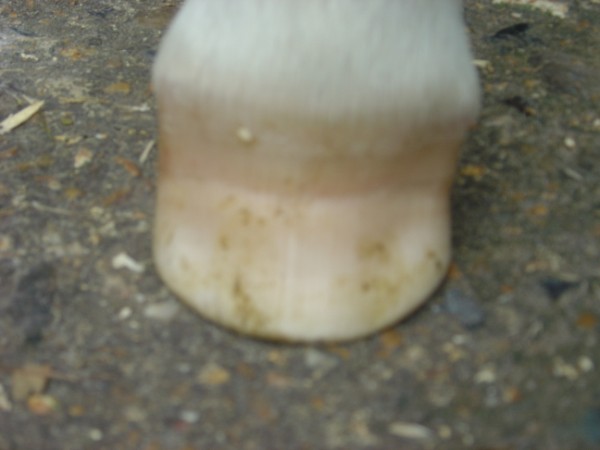
|
| Moderator: DrO |
Posted on Thursday, Aug 13, 2009 - 4:14 am: Hello CathyYou can definitely see 1/2 way down the foot where there is a distinctive change in the angle of hoof wall growth as it has became more upright recently. The coronary has a enlarged appearance which may be due to the forward rotation of the extensor process but there may be a bit of congestion in the coronet itself. Let me correct two notions you present above. Foals are easily weaned as early as two months and can be done at two weeks of age without permanent harmful results. As to your mares condition she is likely to more a moderate than flesh with the edges of the ribs showing. It is not the images that tell us how difficult to treat this condition is. The severity is best assessed in light of the history: were correctable mistakes made or did this happen with everything being done perfectly. In the first case prognosis is good but in the second case a guarded to fair prognosis should be considered at preventing a club foot without surgery . DrO |
| Member: cathy33 |
Posted on Thursday, Aug 13, 2009 - 12:22 pm: Hi Dr O, thank you for your comments. I do find this forum very useful.I have attached further photos to try and show Harley's pastern development through time. I have tried very hard to do everything right since birth but I am a first time breeder so am sure there is plenty of scope to get things wrong (despite researching stuff and consulting my vet and farrier). As you can see Harley had DrOpped fetlocks on his hinds at birth so I suppose I focussed on that (and the plasma transfusions he needed in the first week because of failed colostrum transfer) rather than his fores which seemed fine. He was also over at the knee on his front legs but this has righted itself. Looking at the photos I think his pasterns became quite upright early on although I only noticed the hoof deformity at 5 1/2 weeks. I am sure it was probably there well before that though, and probably started soon after birth given the amount of growth involved. I really don't know if his current problems are due to correctable mistakes or not. Both parents are quite upright but not excessively so and I know of no history of club feet. Certainly the mare's nutrition was good and Harley started grazing himself very early on and the grass is very lush. I tried the grazing muzzle today for just an hour. Harley just looked rather confused!! It will at least stop him from taking some of the hard feed. Would massaging help? Do you think controlled exercise (ie leading him in a sand school) would be beneficial. Lastly, at what point in time should I consider surgery. I don't want to leave it so long that surgery is no longer an option. Many thanks, Cathy 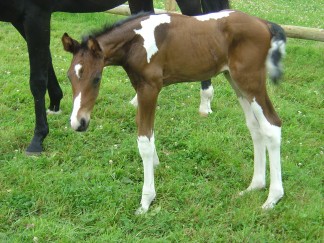 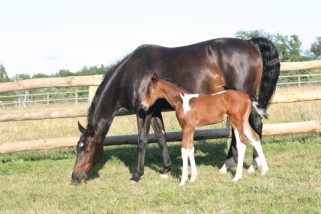 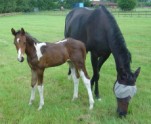 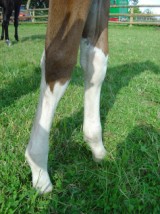
|
| Member: cathy33 |
Posted on Thursday, Aug 13, 2009 - 5:20 pm: One other thing Dr O, I would be interested to know why you think the foal hoof is a different colour where it has grown out steeper?Many thanks |
| Moderator: DrO |
Posted on Friday, Aug 14, 2009 - 2:46 am: Cathy, taking your questions in order:1) No, massage is not likely to be beneficial. 2) Generally exercise is thought to strengthen the muscle tendon unit so during correction it is generally discouraged. 3) If after more conservative attempts you go for several weeks without improvement, surgery should be contemplated. 4) I think it is just the difference between newer and older hoof growth: as the wall ages and dries it looses some translucency. Note that the change in color does not fall exactly on the change in angle. Cathy did you follow the link in article to the article on club footedness? It contains more information including expounds on some of these issues you are asking about. DrO |
| Member: cathy33 |
Posted on Friday, Aug 14, 2009 - 3:13 am: Thank you Dr O. I will follow that link certainly and keep you posted of the situation.Cathy |
| Member: cathy33 |
Posted on Friday, Nov 13, 2009 - 5:00 pm: Dr O, Just thought I'd let you know that after careful control of diet and exercise and with regular trimming, my foal's feet have come good. Thank you for your advice in the earlier postsCathy |
| Moderator: DrO |
Posted on Saturday, Nov 14, 2009 - 6:47 am: Great news Cathy, thank you for the update.DrO |
Horseadvice.com
is The Horseman's Advisor
Helping Thousands of Equestrians, Farriers, and Veterinarians Every Day
All rights reserved, © 1997 -
is The Horseman's Advisor
Helping Thousands of Equestrians, Farriers, and Veterinarians Every Day
All rights reserved, © 1997 -
